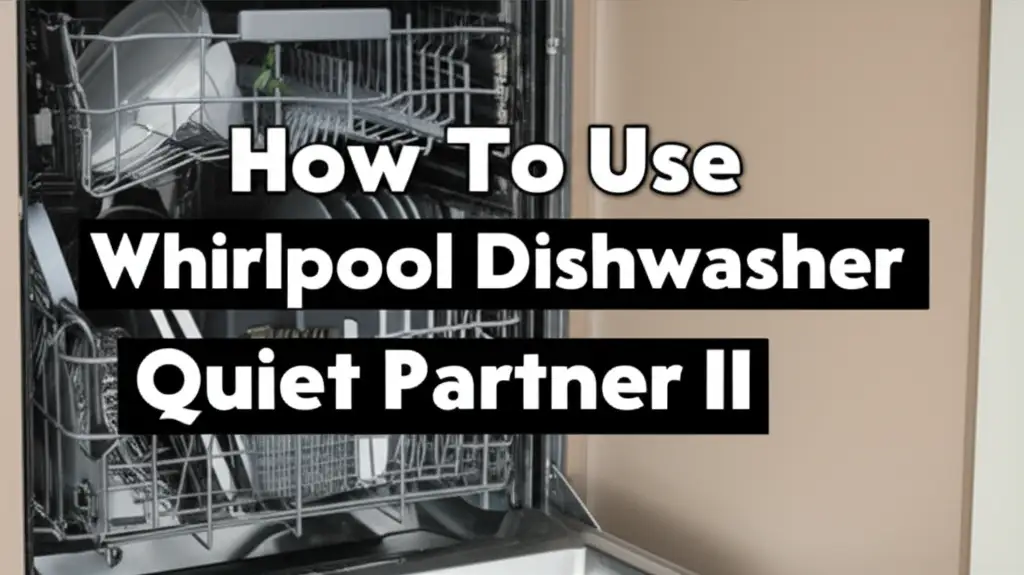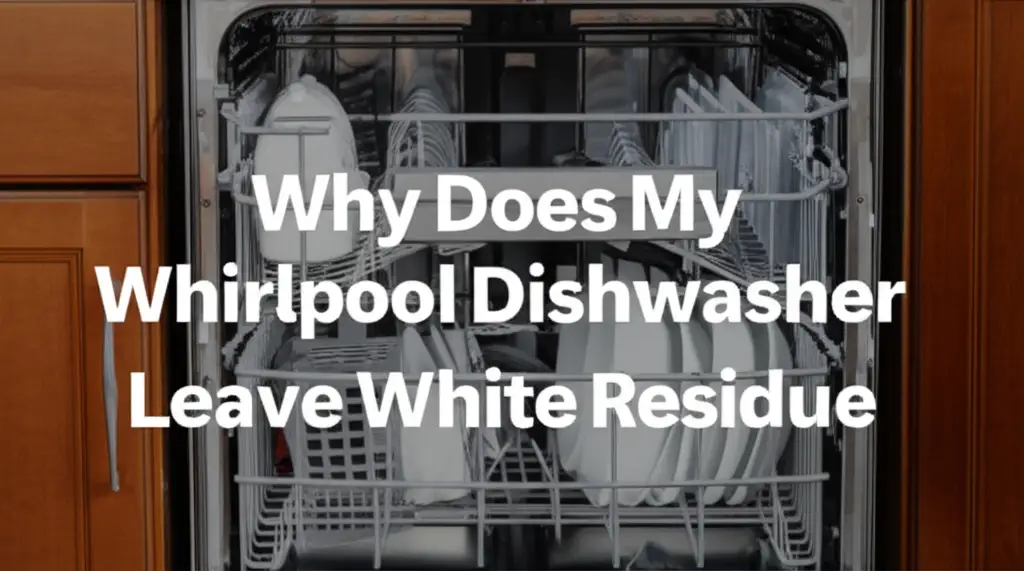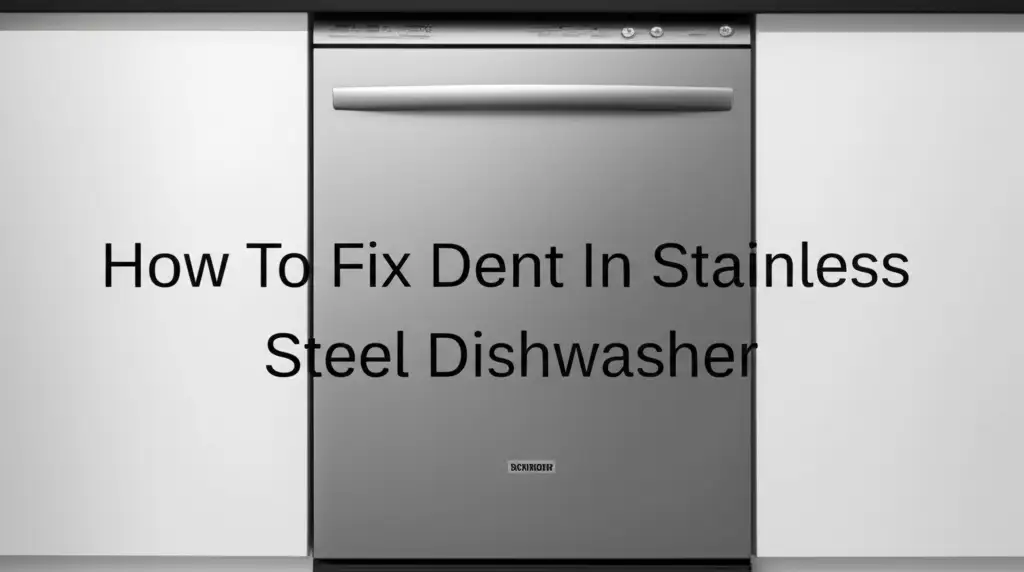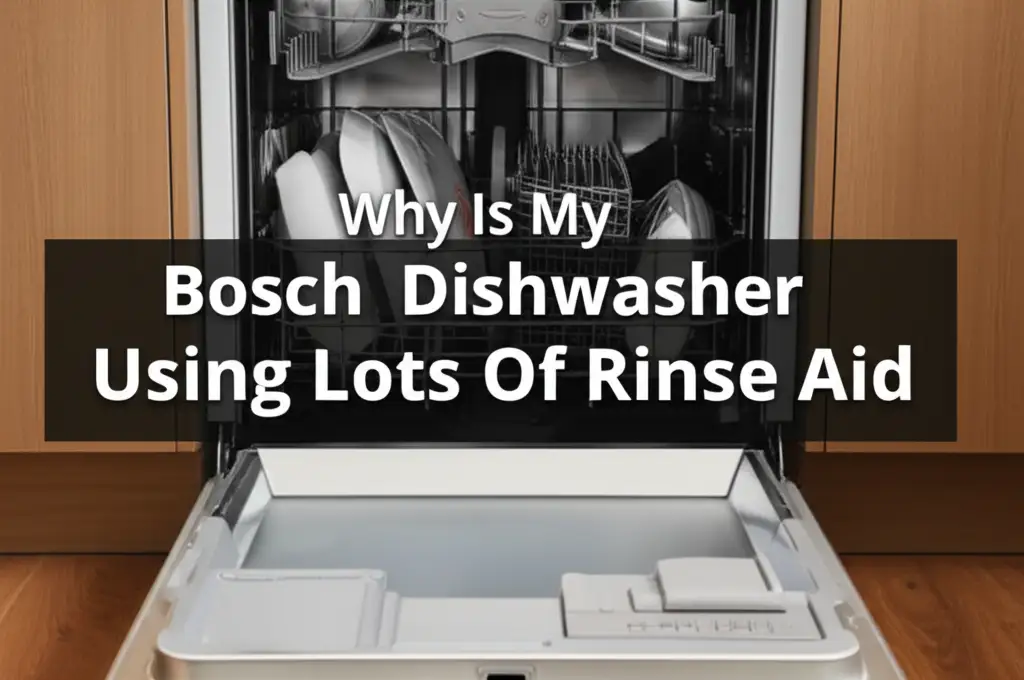· Todd Martin · Home Appliances · 12 min read
How To Use Whirlpool Dishwasher Quiet Partner Ii

Mastering Your Whirlpool Quiet Partner II Dishwasher for Optimal Performance
Welcome to the world of effortless dishwashing! You own a Whirlpool Dishwasher Quiet Partner II, a fantastic appliance designed to bring quiet efficiency to your kitchen. I understand you want to get the most out of your machine. This guide will show you exactly how to use Whirlpool Dishwasher Quiet Partner II models effectively. We will cover everything from initial setup and cycle selection to essential maintenance tips and troubleshooting. Get ready to experience truly clean dishes with minimal noise!
Takeaway
- Load dishes correctly to ensure thorough cleaning.
- Select the appropriate wash cycle for your specific load.
- Use the right detergent and consistently refill rinse aid.
- Clean the dishwasher filter regularly for peak performance.
- Understand common issues and simple fixes for smooth operation.
Answer to the Main Query
To use your Whirlpool Dishwasher Quiet Partner II, load dishes properly, add detergent and rinse aid, select a suitable wash cycle like Normal or Heavy, and press Start. Regular filter cleaning and correct loading optimize performance, ensuring spotless dishes and quiet operation.
Getting Started: Initial Setup and First Wash
Bringing a new appliance into your home is exciting. Your Whirlpool Dishwasher Quiet Partner II offers a blend of performance and quiet operation. Before you load your first dirty dish, make sure your dishwasher is ready. Proper installation forms the base for efficient use. Follow the manufacturer’s installation steps carefully.
Unpacking and Installation Checks
Your dishwasher needs proper unboxing. Remove all packing materials from inside the tub. Check for any shipping damage before you begin. Ensure the water supply line connects securely. The drain hose must also be correctly installed to prevent leaks. These steps ensure your machine works as it should from day one.
Loading Your Dishwasher Efficiently
Efficient loading helps your dishes get clean. Place larger items in the lower rack. This includes dinner plates and serving bowls. Cups and glasses go in the upper rack. Make sure no items block the spray arms. Proper spacing allows water and detergent to reach every surface. If you need a more general guide on how to load any dishwasher, consider reading how to use dishwasher.
For cutlery, use the designated basket. Point forks and spoons handles up for safety. Knives should point handles down. Avoid overcrowding the dishwasher. Overloading prevents thorough cleaning. It also stops proper drying. A well-loaded dishwasher gets dishes sparkling.
Selecting the Right Wash Cycle for Your Needs
Your Whirlpool Quiet Partner II offers various wash cycles. Each cycle serves a specific purpose. Choosing the correct cycle saves energy and water. It also ensures your dishes get the best clean. Understand what each option does before you start a wash.
Understanding Cycle Options
Common cycles include “Normal,” “Heavy,” and “Light/Delicate.” “Normal” works for daily loads with average soil. This is the most used cycle for most households. “Heavy” is for pots, pans, and baked-on food. It uses more water and heat for tough messes. “Light/Delicate” protects fragile items. It uses less aggressive spray and lower temperatures.
Some models also feature specialized cycles. These might include “Sensor” or “Auto.” This cycle detects soil levels automatically. It adjusts water and temperature as needed. “Sani Rinse” adds a high-temperature rinse. This option kills germs for extra hygiene. Choose the cycle that matches your dish load.
When to Use Specific Cycles
You should use the “Normal” cycle for everyday dishes. This includes plates, cups, and silverware after a meal. For a large family dinner, with lots of cooking, pick “Heavy.” This handles casserole dishes and greasy pans. If you wash wine glasses or fine china, select “Light/Delicate.” This protects them from damage. Consider using the “Sani Rinse” for baby bottles or cutting boards. This ensures extra sanitation. Your choice impacts cleanliness and efficiency.
Detergent and Rinse Aid: The Perfect Combination
The right cleaning agents are vital for sparkling dishes. Using proper detergent ensures powerful cleaning action. Rinse aid prevents spots and aids drying. Your Whirlpool Quiet Partner II depends on these for top results. Never skip them if you want truly clean dishes.
Choosing the Right Detergent Type
Your dishwasher needs automatic dishwasher detergent. Do not use hand dish soap. Hand soap creates too many suds. This can damage your machine and cause overflows. Detergent comes in various forms. You can find powder, liquid, gel, or pods. Pods are convenient and pre-measured. You can learn where to put dishwasher pods Whirlpool for optimal use.
Follow the detergent manufacturer’s instructions for dosage. Too much detergent can leave residue. Too little might not clean dishes well. Most detergent dispensers have lines to guide you. For hard water, you might need slightly more detergent. Using the right amount helps your dishwasher perform best. If you are unsure about liquid options, check can you use dishwasher liquid in dishwasher.
Dispensing Rinse Aid for Spotless Dishes
Rinse aid helps water sheet off dishes. This prevents water spots and streaks. It also improves drying performance. Your Whirlpool dishwasher has a dedicated rinse aid dispenser. This dispenser is usually near the detergent dispenser. Fill it until the indicator shows full.
The dispenser releases rinse aid during the final rinse. You typically only need to refill it once a month. The low rinse aid indicator light will tell you when. Using rinse aid is crucial for spotless, dry dishes. It also helps plastic items dry better. For detailed instructions, refer to how to use the rinse aid for Whirlpool dishwasher.
Loading Techniques for Superior Cleaning
Correct loading is not just about fitting everything in. It is about maximizing water circulation. Proper loading ensures every dish gets cleaned. It also prevents damage to your items. Follow these tips for the best results every time.
Optimizing Rack Space
The bottom rack holds large, durable items. Place dinner plates, serving platters, and pots here. Face the dirtiest surfaces towards the spray arm in the center. Avoid nesting items together. Water cannot reach hidden surfaces. Tall items should not block the upper spray arm.
The upper rack is for glasses, cups, and smaller bowls. Place glasses upside down. Angle bowls to allow water to drain. Make sure lightweight plastic items are secure. They can flip over during the wash. This prevents them from filling with water. Your dishwasher works best when items are spaced.
Avoiding Common Loading Mistakes
One common mistake is pre-rinsing dishes too much. Your dishwasher detergent works best with some food soil. Just scrape off large food particles. Do not rinse the dishes clean. Another error is blocking the spray arms. Always check that spray arms can spin freely. Tall items or large utensils can obstruct them.
Mixing different metal types, like silver and stainless steel, can cause discoloration. Do not place wood or cast iron items inside. These materials can warp or rust. Be mindful of delicate items. Always secure them properly. Correct loading ensures a successful wash.
Essential Maintenance for Longevity and Performance
Regular maintenance keeps your Whirlpool Quiet Partner II running smoothly. It prevents common problems and extends its lifespan. Clean components ensure efficient operation. A well-maintained dishwasher cleans dishes better. It also prevents unpleasant odors.
Cleaning the Filter Regularly
Your dishwasher has a filter system. This filter catches food particles. Over time, it can become clogged. A clogged filter reduces cleaning performance. It can also cause odors. You should clean your filter regularly. Check it once a month, or more often if you wash very soiled dishes.
Most Quiet Partner II models have a removable filter. Twist and pull it out. Rinse it under running water to remove debris. Use a soft brush for stubborn spots. Then, put it back in place. Proper filter maintenance is key. Learn how to clean dishwasher filter Whirlpool Quiet Partner II for specific steps. Once cleaned, it is important to know how to put Whirlpool dishwasher filter back in.
Keeping Spray Arms Clear
The spray arms have small holes, called jets. Water sprays out of these jets to clean dishes. Food particles can sometimes block these holes. This reduces the cleaning power. Periodically check the spray arms for blockages. Remove any debris you find.
You can often unscrew the spray arms for a deeper clean. Rinse them under warm water. Use a toothpick or small wire to clear blocked jets. Make sure they spin freely after reattaching them. Clear spray arms ensure uniform water distribution. This helps your dishes get sparkling clean.
Troubleshooting Common Whirlpool Quiet Partner II Issues
Even the best appliances can have issues. Your Whirlpool Quiet Partner II might occasionally show problems. Knowing how to troubleshoot saves time and money. Many common issues have simple solutions. Do not panic if something goes wrong.
Addressing Washing Problems
If dishes are not getting clean, several things could be wrong. First, check your loading. Overcrowding is a frequent cause. Ensure spray arms are not blocked. Verify you used enough detergent. Also, check the filter; a dirty filter stops proper cleaning. Ensure your water temperature is hot enough. Water around 120°F (49°C) is ideal for effective cleaning. Run the hot water tap in your sink before starting the dishwasher. This brings hot water to the unit.
Sometimes, white film appears on dishes. This usually indicates hard water or too little rinse aid. Try increasing the rinse aid setting. A cloudy appearance can mean too much detergent. Adjust the detergent amount. Understanding these common problems helps you fix them quickly.
Handling Water Drainage Issues
You might open your dishwasher to find water pooled at the bottom. This means your dishwasher is not draining. Check if the drain hose is kinked. A kinked hose blocks water flow. Ensure your sink’s air gap (if present) is clear. Food debris can block it. Sometimes, the filter is clogged. A dirty filter prevents water from draining properly. You can learn more about why does my Whirlpool dishwasher have water in the bottom.
If the dishwasher fills but does not wash, the spray arms might not be spinning. Or the pump could be faulty. You can read about why does my Whirlpool dishwasher fill with water but not wash. If the dishwasher is not filling at all, check the water supply line. Make sure the water valve is open. Also, check for kinks in the water supply hose. Learn about why won’t my Whirlpool dishwasher fill with water for solutions. Many issues are minor and fixable.
Maximizing Quiet Operation and Efficiency
The “Quiet Partner II” in your dishwasher’s name means it is designed to be quiet. This is a significant benefit in open-concept homes. Understanding its quiet features helps you maximize them. You can also take steps to keep your machine operating quietly and efficiently.
Understanding Quiet Partner II Technology
Whirlpool’s Quiet Partner II models use special insulation. They also have a sound-dampening system. This reduces noise during the wash cycle. Advanced motors and pumps also run silently. The goal is to let you run your dishwasher anytime without disturbance. This technology allows for quieter kitchens.
The decibel rating for these models is usually low. This makes them ideal for homes where noise is a concern. A quiet dishwasher improves your living space. It means you can have conversations or watch TV while it runs. For general information, learn what decibel is quiet for a dishwasher. Your Quiet Partner II model is built with noise reduction in mind.
Tips for a Quieter Wash
Beyond the built-in features, you can help keep your dishwasher quiet. Proper loading is important. Clanking dishes make noise. Make sure items are secure in the racks. Do not let them touch each other. Check for loose items inside the tub before starting.
Regular maintenance also helps. A clean filter prevents clogs that might strain the pump. A strained pump can create more noise. Ensure the dishwasher is level. An unlevel appliance can vibrate more. This creates unwanted sound. Following these tips ensures your Quiet Partner II lives up to its name.
FAQ Section
Q1: How do I select the best cycle for heavily soiled dishes? For heavily soiled dishes, choose the “Heavy” wash cycle. This cycle uses more water and higher temperatures. It effectively tackles baked-on food and grease. Pre-scraping large food particles also helps. Do not pre-rinse too much, as detergent needs some food soil to activate.
Q2: Why are my dishes not drying properly? If dishes are wet after a cycle, check your rinse aid dispenser. It might be empty. Rinse aid helps water sheet off and improves drying. Ensure you have selected a heated dry option if your model offers one. Overcrowding the dishwasher can also prevent proper drying.
Q3: How often should I clean the dishwasher filter? You should aim to clean your dishwasher filter at least once a month. If you wash dishes with a lot of food debris, like after a big meal, check it more often. A clean filter ensures optimal cleaning performance and prevents odors. It is a quick and simple task.
Q4: Can I use regular dish soap in my Quiet Partner II? No, you must never use regular hand dish soap in your dishwasher. Hand soap produces excessive suds. This can cause overflows and damage your appliance. Only use automatic dishwasher detergent specifically designed for dishwashers.
Q5: What does the “Quiet Partner II” designation mean for noise levels? “Quiet Partner II” indicates that your dishwasher has advanced sound insulation. It also includes special components for reduced operational noise. This design makes the dishwasher quieter during cycles. You can often run it without disturbing household activities.
Conclusion
You now have a strong understanding of how to use Whirlpool Dishwasher Quiet Partner II models. From careful loading to cycle selection and regular maintenance, each step matters. We covered how to get your machine ready, how to choose the right detergent, and important cleaning steps. Proper care ensures your dishes come out sparkling clean. It also helps your appliance last longer. By following these simple steps, you will enjoy quiet, efficient dishwashing for years. Make the most of your Whirlpool Quiet Partner II today!
- Whirlpool dishwasher
- Quiet Partner II
- Dishwasher usage
- Kitchen appliance guide
- Dishwasher maintenance
- Quiet dishwashers





